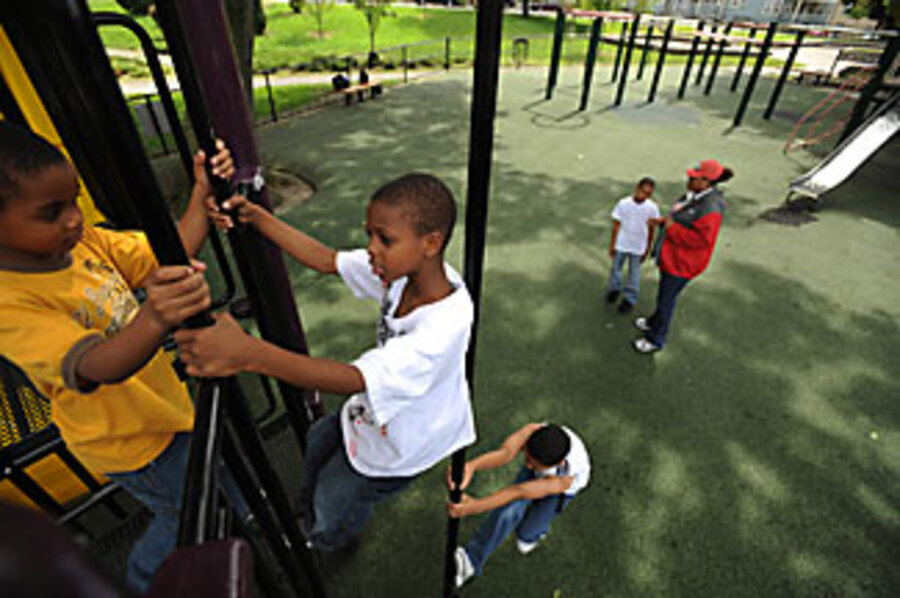Boston's newest classrooms: schoolyards
The Boston Schoolyard Initiative started with parents and teachers clamoring for safe places where they could tell kids to "go outside and play." As it has evolved, its new motto could be: "Go outside and learn."
The effort to renovate school sites and add "outdoor classrooms" has become a national model as cities struggle to address both childhood obesity and academic gaps.
Like many city schoolyards, Boston's had largely been paved over because old, rotting play structures posed safety hazards. The shortage of open green space for children became so acute that Mayor Thomas Menino launched the initiative in 1995, bringing together city and school leaders, local residents, and private funders to create inviting outdoor settings for schools and communities to share.
It started with transforming asphalt wastelands into colorful climbing structures, landscaped walking paths, and space for public art. In 2005, the initiative began adding outdoor classrooms – mini wilderness zones, gardening areas, and other features that teachers use for everything from science lessons to writing projects.
"We don't refer to them as playgrounds, because they are more than that," says Kim Comart, interim director of the Boston Schoolyard Funders Collaborative, the private side of the partnership.
Representatives of six cities toured several of the schoolyards last week. From Charleston, S.C., to San Antonio, they are working to promote local wellness through grants from the Robert Wood Johnson Foundation and technical assistance from the National League of Cities and the American Association of School Administrators (AASA).
"School leaders over the last few years have really started to look at these connections between health and wellness and kids being successful in schools," says Rebecca Roberts, a project director at AASA. The Boston model shows that even with tight school budgets, such efforts can be sustained when they draw on private funding and community support.
Help could be on the way from the federal government, too. A bill introduced in Congress, the No Child Left Inside Act, would increase funding for states to promote environmental education and outdoor learning, which supporters say have received less attention because of the testing focus of the No Child Left Behind Act.
Since 1995, Boston has reconstructed 71 schoolyards, covering 125 acres and serving more than 25,000 children a day, Mr. Comart says. The yearly capital investment is about $1.2 million from the city and $600,000 from the Funders Collaborative, which also gives about $450,000 for operating expenses and professional development for teachers. By 2010, 87 yards should be complete, he says, and 27 will include outdoor classrooms. The hope now is to complete the 10 remaining elementary- and middle-school yards.
The teachers on hand during the tour made it easy for visitors to imagine children's delight in the outdoor classroom at the William Monroe Trotter Elementary School in Boston's Dorchester neighborhood. Third-grade teacher Christine Whittemore's face lit up as she explained the concept of the garden she stood in: Corn, beans, and squash all grow in one plot – a "three sisters" garden like the kind the Wampanoag Indians showed to the Pilgrims. It ties in well with social studies lessons, she said.
The area used to be a vacant, trashy lot and now nurtures plants that attract butterflies. A square wooden pole sports a weather vane and thermometers, so students can correlate temperature to where the sun is.
"[The kids] sort of recognize this as kind of a special place. They're quieter, more orderly," Ms. Whittemore said.
Researchers have looked at the effect on learning outcomes. In Boston schools with renovated yards, about 25 percent more fourth-graders passed the state math test, after controlling for such factors as family income.
Everyone involved deserves credit for the "passion" surrounding these spaces, says Russ Lopez, an environmental health professor at Boston University who co-wrote that study. "If the school department had just gone in and rebuilt the schoolyard, I don't think there would have been nearly as good an impact.... The fact that they got the teachers involved, and the parents and neighborhoods, ... made this project more successful."
Visitors from Oakland, Calif., enjoyed seeing up close what they've already turned to as a model. The relatively new Oakland Schoolyard Initiative seeks to transform 50 schoolyards over the next 10 years. Meanwhile, the collaboration has sparked creative solutions. "Our schools, all they have is asphalt," said Michelle Doppelt of the Oakland Parks and Recreation Department. A park she oversees has grass and a creek, while the nearby school has only a basketball court. "We swap usage," she said, so park programs can include basketball and schoolchildren can do gardening.
The outdoor classrooms and curriculum made an impression as well. "So much has been all about testing, all about the classroom, but science is much more than that," said Scott Burg, who served as a consultant on health and wellness for the Oakland Unified School District. "This is all science," he said, motioning toward trees as he walked through one of the schoolyard sites. "Get the kids outside."





